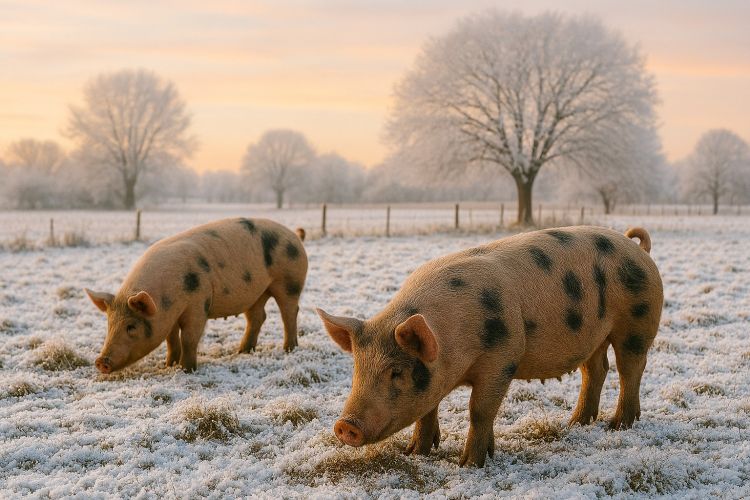Management over medication: Parasite control going into winter
Keeping your pigs healthy through the cold months.

As the days grow shorter and temperatures drop, it is time to start preparing for winter with your pigs. One of the most crucial steps is controlling parasites. They might not always be visible, but parasites can slow growth, make feed less effective by competing for nutrients and weaken your pigs’ immune systems, leaving them more vulnerable to other health problems. That is especially frustrating in winter, when feed costs rise and pigs have limited access to pasture.
Start with fecal testing
A great place to start is with a fecal test. Checking your pigs’ manure for parasite eggs lets you see exactly which animals need treatment, so you don’t give medicine unnecessarily. Taking this step not only protects your pigs but also helps you choose the best dewormer at the most correct time, preventing parasites from developing resistance.
For small farms, testing twice a year, spring and fall, is usually sufficient, though herds with a history of heavy parasite loads may need to test more frequently.
Collecting fecal samples is straightforward. This process begins with gathering fresh feces from a few pigs, placing them in a clean container and sending them to a veterinarian or an Extension lab. The results will inform a potential treatment plan to help you effectively manage parasites.
Smart deworming strategies
Don’t treat the whole herd unless testing shows a heavy parasite burden. Instead, focus on pigs showing signs like:
- Slow growth or poor weight gain
- Rough, dull coat
- Pale gums or anemia
- Diarrhea or scours
Some of the most used dewormers are fenbendazole, ivermectin, and levamisole. It’s important to follow the label and dose according to each pig’s weight; underdosing is one of the quickest ways parasites develop resistance, which makes treatments less effective over time. Measuring carefully ensures the medication works as intended and keeps your pigs healthy.
Swine dewormer comparison chart
|
Dewormer Class |
Common Products |
Effective Against |
Key Notes |
Rotation Tip |
|
Benzimidazoles |
Fenbendazole (Safe-Guard) |
Roundworms, Whipworms, Nodular Worms, Kidney Worms |
Broad-spectrum; safe for most pigs |
Rotate with other classes to prevent resistance |
|
Macrocyclic Lactones |
Ivermectin, Doramectin (Dectomax) |
Lungworms, Stomach Worms, Intestinal Worms, Threadworms |
Effective against internal and some external parasites |
Rotate with other classes for best results |
|
Imidazothiazoles |
Levamisole (LevaMed) |
Roundworms, Whipworms, Nodular Worms, Kidney Worms |
Targets roundworms; usually oral; short withdrawal period |
Alternate with other classes to reduce resistance risk |
Table Reference: RJ Matthews Swine Dewormer Comparison Chart
Tips for using dewormers effectively
- Always weigh pigs to calculate the correct dose.
- Treat only pigs that need it whenever possible.
- Rotate drug classes over time to prevent resistance.
- Follow withdrawal times if pigs are intended for meat.
Reducing overwinter parasite loads
Winter management can make a big difference:
- Keep pens clean: Remove manure often to break the parasite life cycle.
- Provide dry bedding: Damp bedding helps parasite eggs and larvae survive.
- Avoid overcrowding: More pigs in a small area means higher parasite exposure.
- Rotate or rest pastures: Worm eggs can survive in soil for months, even under snow. Moving pigs to clean or rested paddocks in spring helps reduce reinfection.
Taking time to manage parasites through the winter can make a big difference in your pigs’ overall health. Regular fecal testing, targeted treatments and keeping pens clean and dry all help reduce parasite problems and protect the effectiveness of dewormers. Consistent care now will set your herd up for a healthier and more productive spring. Finally, give pigs plenty of space and rotate pastures whenever possible; resting the land and reducing crowding help lower the risk of reinfection.



 Print
Print Email
Email




